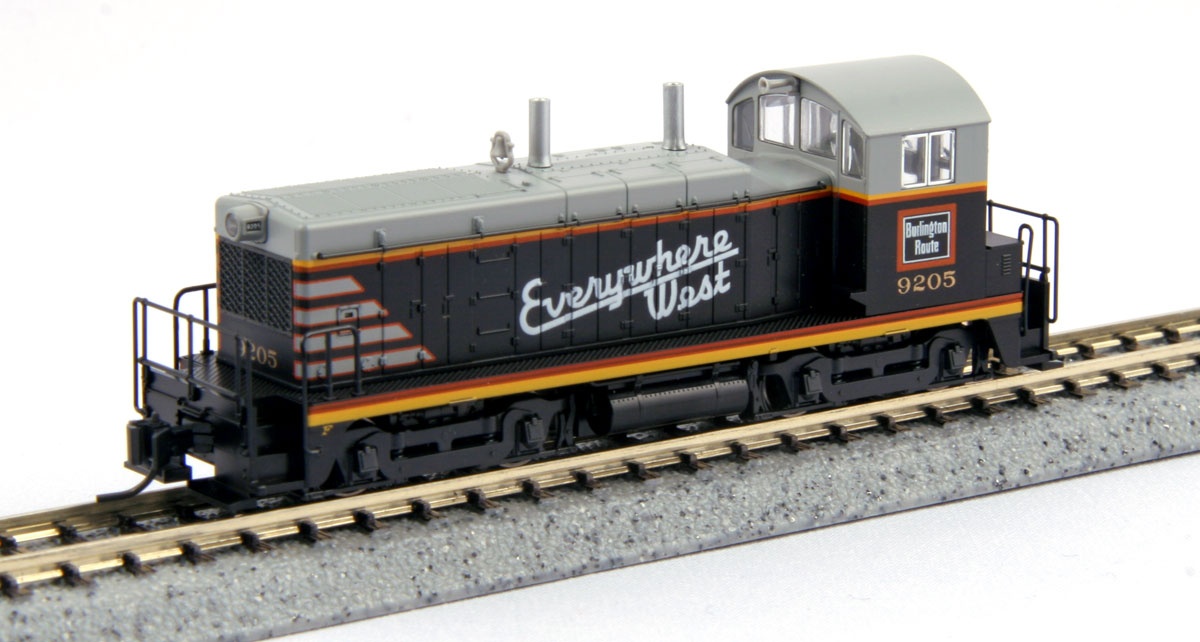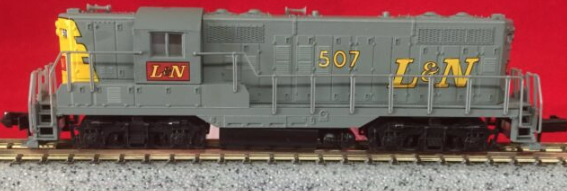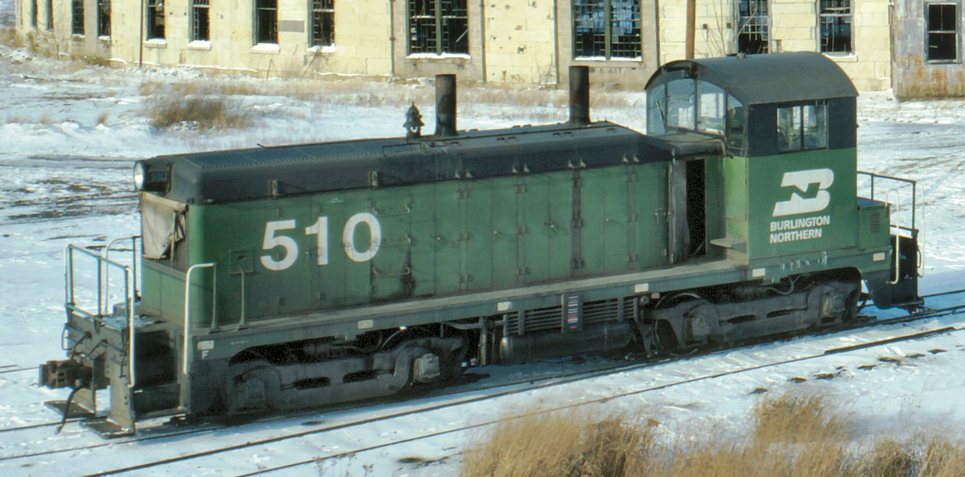Model Information: Kato introduced the NW2 switcher in 2007. This was Kato's first North American "Yard Switcher" and required Kato engineering a challenge to match the quality of their earlier releases using less physical space. The engine comes in DCC-Ready and DCC-Equipped (a rarity for Kato) versions.
This is a standard modern engine with flywheels, split-frame, blackened wheels and knuckle couplers. It runs smoothly and quietly and has been very popular with Kato fans (it being the first Kato switcher). The modern LED's light up the number-boards as well as the directional lights. It even sports interior cab details.
This is a standard modern engine with flywheels, split-frame, blackened wheels and knuckle couplers. It runs smoothly and quietly and has been very popular with Kato fans (it being the first Kato switcher). The modern LED's light up the number-boards as well as the directional lights. It even sports interior cab details.
DCC Information: For the DCC-ready versions, owners can install the DN123K3 decoder.
Prototype History: The EMD NW2 is a 1,000 hp (750 kW), B-B switcher locomotive manufactured by General Motors Electro-Motive Division of La Grange, Illinois. The NW2 was manufactured from February 1939 to December 1949, and 1145 were produced – 1121 for the U.S., and 24 were exported to Canada. The 1,000 hp (750 kW) was achieved by using a 12-cylinder, model 567, and later, a model 567A engine.
EMD also offered a cow-calf version of the NW2 known as the TR, TR2, and TR3; 3 TR cow-calf paired sets, 36 TR2 cow-calf paired sets, and 2 TR3 cow-calf-calf sets were produced. The TR sets were built prior to World War II and the TR2 and TR3 sets were built postwar.
EMD’s NW2 switcher’s lifetime was nearly cut short just three years after its introduction, with the establishment of the War Production Board in 1942, which dictated that EMD was to halt all production of switching locomotives, manufacturing only road diesels during the years of 1942 to 1945. However, such was the popularity of this end cab switching locomotive that after the restriction was lifted, the NW2 sprung back as many railroads placed orders for this little 1000hp powerhouse; today these locomotives can still be found enjoying continued service in rail yards. They were to wear paint for 88 different railroads ... from class 1 giants such as UP (with 95 units, the largest user) all the way down to short-line and industrial roads with but 1 on the roster.
From Wikipedia
Read more on American-Rails.com.
EMD also offered a cow-calf version of the NW2 known as the TR, TR2, and TR3; 3 TR cow-calf paired sets, 36 TR2 cow-calf paired sets, and 2 TR3 cow-calf-calf sets were produced. The TR sets were built prior to World War II and the TR2 and TR3 sets were built postwar.
EMD’s NW2 switcher’s lifetime was nearly cut short just three years after its introduction, with the establishment of the War Production Board in 1942, which dictated that EMD was to halt all production of switching locomotives, manufacturing only road diesels during the years of 1942 to 1945. However, such was the popularity of this end cab switching locomotive that after the restriction was lifted, the NW2 sprung back as many railroads placed orders for this little 1000hp powerhouse; today these locomotives can still be found enjoying continued service in rail yards. They were to wear paint for 88 different railroads ... from class 1 giants such as UP (with 95 units, the largest user) all the way down to short-line and industrial roads with but 1 on the roster.
From Wikipedia
Read more on American-Rails.com.
Road Name History: The Chicago, Burlington and Quincy Railroad (reporting mark CBQ) was a railroad that operated in the Midwestern United States. Commonly referred to as the Burlington or as the Q, the Burlington Route served a large area, including extensive trackage in the states of Colorado, Illinois, Iowa, Kentucky, Missouri, Montana, Nebraska, Wisconsin, Wyoming, and also in New Mexico and Texas through subsidiaries Colorado and Southern Railway, Fort Worth and Denver Railway, and Burlington-Rock Island Railroad.[citation needed] Its primary connections included Chicago, Minneapolis-St. Paul, St. Louis, Kansas City and Denver. Because of this extensive trackage in the midwest and mountain states, the railroad used the advertising slogans "Everywhere West", "Way of the Zephyrs", and "The Way West". It merged into Burlington Northern in 1970.
In 1967, it reported 19,565 million net ton-miles of revenue freight and 723 million passenger miles; corresponding totals for C&S were 1,100 and 10 and for FW&D were 1,466 and 13. At the end of the year CB&Q operated 8,538 route-miles, C&S operated 708 and FW&D operated 1362. (These totals may or may not include the former Burlington-Rock Island Railroad.)
Information sourced from Wikipedia
In 1967, it reported 19,565 million net ton-miles of revenue freight and 723 million passenger miles; corresponding totals for C&S were 1,100 and 10 and for FW&D were 1,466 and 13. At the end of the year CB&Q operated 8,538 route-miles, C&S operated 708 and FW&D operated 1362. (These totals may or may not include the former Burlington-Rock Island Railroad.)
Information sourced from Wikipedia
Brand/Importer Information: KATO U.S.A. was established in 1986, with the first U.S. locomotive model (the GP38-2, in N-Scale) released in 1987. Since that time, KATO has come to be known as one of the leading manufacturers of precision railroad products for the modeling community. KATO's parent company, Sekisui Kinzoku Co., Ltd., is headquartered in Tokyo, Japan.
In addition to producing ready-to-run HO and N scale models that are universally hailed for their high level of detail, craftsmanship and operation, KATO also manufactures UNITRACK. UNITRACK is the finest rail & roadbed modular track system available to modelers today. With the track and roadbed integrated into a single piece, UNITRACK features a nickel-silver rail and a realistic-looking roadbed. Patented UNIJOINERS allow sections to be snapped together quickly and securely, time after time if necessary.
The Kato U.S.A. office and warehouse facility is located in Schaumburg, Illinois, approximately 30 miles northwest of Chicago. All research & development of new North American products is performed here, in addition to the sales and distribution of merchandise to a vast network of wholesale representatives and retail dealers. Models requiring service sent in by hobbyists are usually attended to at this location as well. The manufacturing of all KATO products is performed in Japan.
Supporters of KATO should note that there is currently no showroom or operating exhibit of models at the Schaumburg facility. Furthermore, model parts are the only merchandise sold directly to consumers. (Please view the Parts Catalog of this website for more specific information.)
In addition to producing ready-to-run HO and N scale models that are universally hailed for their high level of detail, craftsmanship and operation, KATO also manufactures UNITRACK. UNITRACK is the finest rail & roadbed modular track system available to modelers today. With the track and roadbed integrated into a single piece, UNITRACK features a nickel-silver rail and a realistic-looking roadbed. Patented UNIJOINERS allow sections to be snapped together quickly and securely, time after time if necessary.
The Kato U.S.A. office and warehouse facility is located in Schaumburg, Illinois, approximately 30 miles northwest of Chicago. All research & development of new North American products is performed here, in addition to the sales and distribution of merchandise to a vast network of wholesale representatives and retail dealers. Models requiring service sent in by hobbyists are usually attended to at this location as well. The manufacturing of all KATO products is performed in Japan.
Supporters of KATO should note that there is currently no showroom or operating exhibit of models at the Schaumburg facility. Furthermore, model parts are the only merchandise sold directly to consumers. (Please view the Parts Catalog of this website for more specific information.)
Item created by: gdm on 2016-01-26 11:37:44. Last edited by gdm on 2020-05-26 15:37:33
If you see errors or missing data in this entry, please feel free to log in and edit it. Anyone with a Gmail account can log in instantly.
If you see errors or missing data in this entry, please feel free to log in and edit it. Anyone with a Gmail account can log in instantly.











